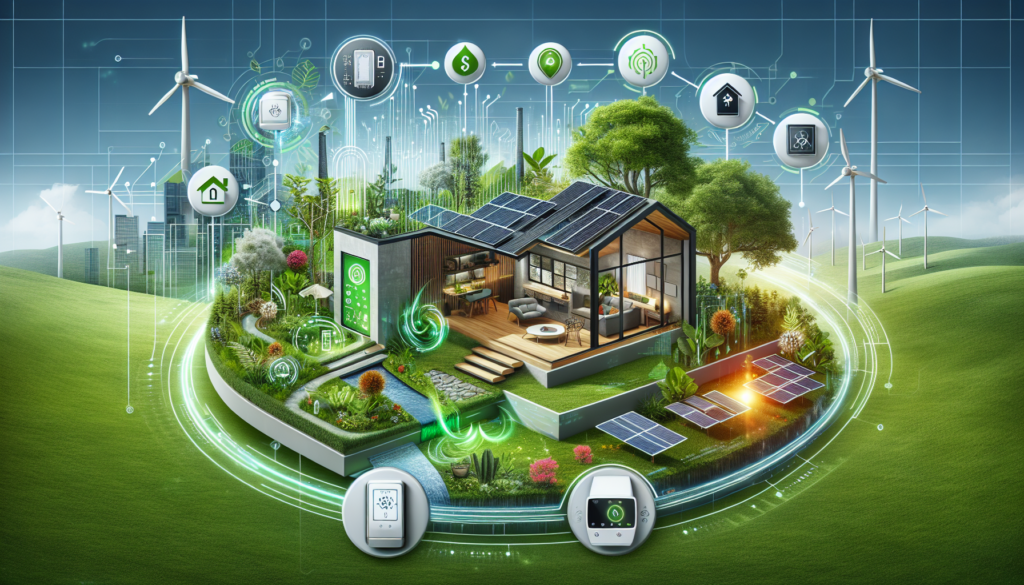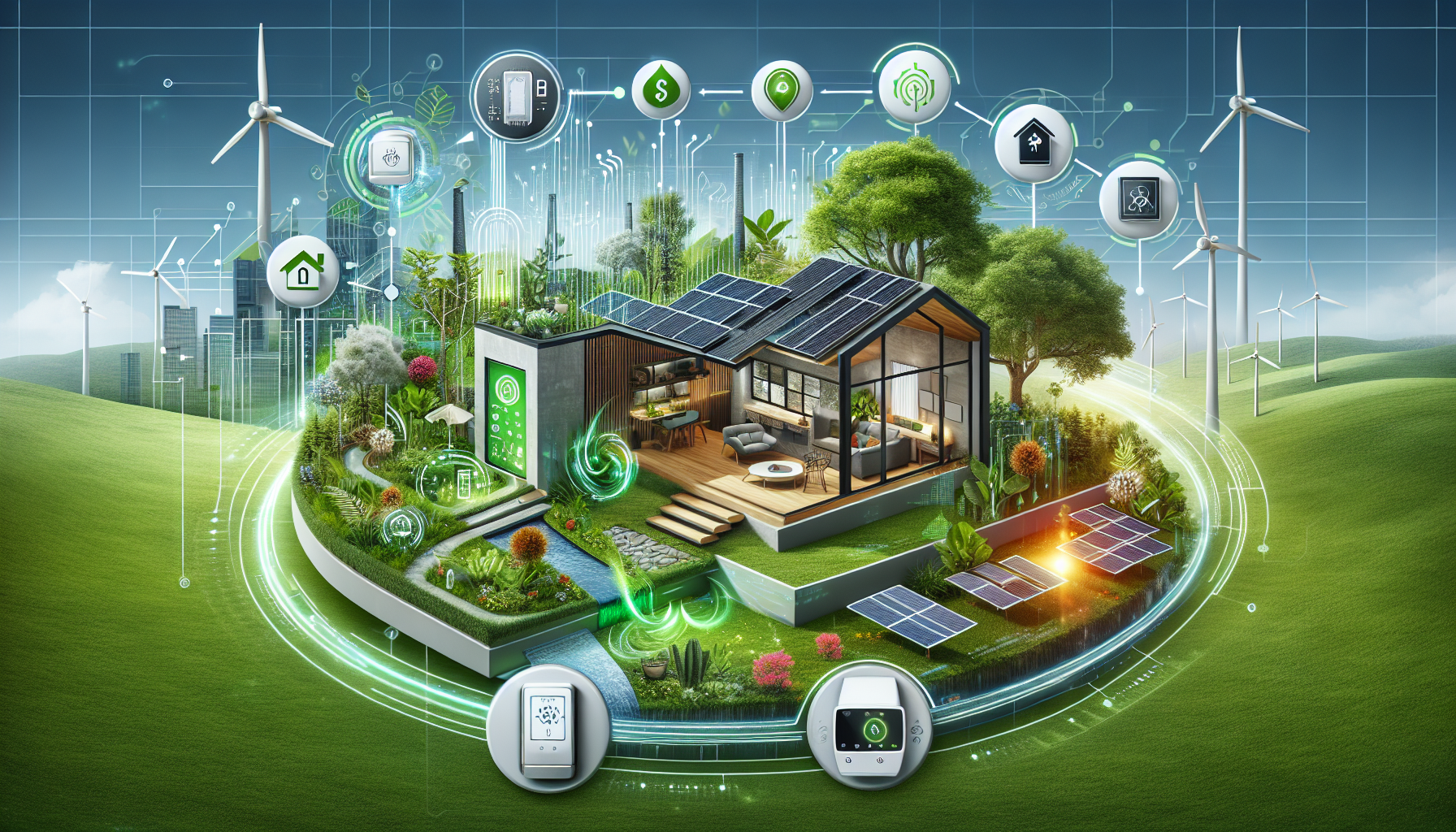Imagine a world where your home can anticipate your comfort needs and adjust its climate accordingly, all while minimizing energy consumption and reducing your carbon footprint. With smart climate control, this vision is becoming a reality. By harnessing the power of artificial intelligence and IoT technology, smart climate control systems are revolutionizing the way we experience our living spaces. From optimizing temperature and humidity levels to intuitively adapting to our preferences, this sustainable approach to climate control not only ensures our comfort but also helps us contribute towards a greener future. Join us as we explore the incredible potential of smart climate control and how it is changing the way we live.
What is Smart Climate Control?
Smart Climate Control refers to the use of advanced technology and automation to regulate and maintain the temperature, humidity, and air quality of a space, such as a building or a vehicle. It is a sustainable approach to climate control that combines innovative sensors, data analysis, and automated control systems to optimize comfort, energy efficiency, and overall environmental sustainability.
Definition of Smart Climate Control
Smart Climate Control can be defined as a system that dynamically adjusts and manages the heating, ventilation, and air conditioning (HVAC) systems based on real-time data, user preferences, and external factors. It utilizes a combination of sensors, data analysis, and automation to create an optimal indoor environment while minimizing energy consumption and carbon footprint.
Importance of Smart Climate Control
Smart Climate Control is becoming increasingly important in the face of climate change and the need to reduce energy consumption. Traditional climate control systems often result in significant energy wastage and greenhouse gas emissions. By intelligently managing the HVAC systems, smart climate control helps to reduce energy usage, lower utility costs, improve indoor air quality, and contribute to a more sustainable future.
Benefits of Smart Climate Control
Smart Climate Control offers numerous benefits to both individuals and organizations. By automatically adjusting the HVAC settings based on occupancy, weather conditions, and user preferences, it ensures optimal comfort while minimizing energy waste. This leads to reduced utility bills, lower carbon footprint, and a healthier living or working environment. Additionally, smart climate control enables remote monitoring and control, providing convenience and peace of mind for users.
How Does Smart Climate Control Work?
Sensors and Data Collection
At the core of smart climate control systems are various sensors that collect real-time data on temperature, humidity, air quality, and occupancy. These sensors are strategically placed throughout the building or space to provide accurate and detailed information. The collected data is then sent to a central control unit for analysis and decision-making.
Data Analysis and Machine Learning
The collected data is analyzed using sophisticated algorithms and machine learning techniques. By analyzing patterns and historical data, the smart climate control system can identify trends and make predictions about temperature and occupancy patterns. This allows the system to proactively adjust the HVAC settings to maximize comfort and energy efficiency.
Automated Control Systems
Based on the analysis of the collected data, the smart climate control system automatically adjusts the HVAC settings, such as temperature, ventilation, and air circulation. This can be done through programmable thermostats, motorized dampers, and variable-speed fans. The automated control systems ensure that the desired comfort level is maintained while minimizing energy consumption.

Key Components of a Smart Climate Control System
Smart Thermostats
Smart thermostats are one of the key components of a smart climate control system. These thermostats are equipped with advanced features, such as Wi-Fi connectivity, occupancy detection, and learning algorithms. They allow users to remotely control and monitor the temperature settings of their space, enabling energy savings and personalized comfort.
Zone Control Systems
Zone control systems divide a building or space into separate zones, each with its own thermostat and dampers. This allows for individual temperature control in different areas, depending on occupancy and preferences. Zone control systems enable targeted heating and cooling, reducing energy waste and increasing comfort.
Occupancy Sensors
Occupancy sensors detect the presence or absence of people in a space. They are used to determine the occupancy status of a room or area and adjust the HVAC settings accordingly. By only heating or cooling occupied areas, energy is conserved, and unnecessary usage is avoided.
Weather Stations
Weather stations are external sensors that monitor and collect data on weather conditions, such as temperature, humidity, and outdoor air quality. This data is used by smart climate control systems to adjust the indoor climate settings in response to external factors. By incorporating real-time weather data, the system can optimize energy consumption and indoor comfort.
Energy Efficiency in Smart Climate Control
Optimal Temperature Settings
Smart climate control systems use data analysis and user preferences to determine the optimal temperature settings for different times of the day and seasons. By avoiding extreme temperature variations and maintaining a comfortable yet energy-efficient temperature range, these systems help reduce energy consumption.
Intelligent Heating and Cooling
Smart climate control systems incorporate intelligent algorithms to optimize heating and cooling processes. For example, by using predictive analytics, the system can pre-cool or pre-heat the space based on occupancy patterns and weather forecasts. This reduces energy waste and ensures that the desired comfort level is achieved at the right time.
Energy Consumption Monitoring
Smart climate control systems enable users to monitor their energy consumption in real-time. By providing detailed energy usage data, users can identify areas of high energy consumption and take corrective measures. This promotes energy conservation and empowers users to make informed decisions about their energy usage.
Smart Scheduling and Automation
Smart climate control systems allow for the scheduling and automation of HVAC settings. Users can program the system to automatically adjust the temperature and ventilation based on their daily routine or occupancy patterns. This eliminates the need for manual adjustments and ensures energy-efficient operation even when the space is unoccupied.

Integration with Renewable Energy Sources
Solar Power Integration
Smart climate control systems can be integrated with solar power systems to harness clean and renewable energy for heating and cooling. By utilizing solar panels to generate electricity, the system can reduce its reliance on fossil fuels and lower carbon emissions. Solar power integration enhances the sustainability and energy efficiency of smart climate control systems.
Geothermal Energy Integration
Geothermal energy, which utilizes the earth’s natural heat, can be combined with smart climate control systems for heating and cooling purposes. By tapping into the stable temperature of the ground, geothermal heat pumps can provide a highly efficient and sustainable heating and cooling solution. Integration with geothermal energy further reduces the environmental impact of smart climate control systems.
Wind Power Integration
Wind power can also be integrated into smart climate control systems through the use of wind turbines. By generating electricity from the wind, the system can power the HVAC systems, reducing reliance on traditional energy sources. Wind power integration contributes to a cleaner and more sustainable operation of smart climate control systems.
Smart Climate Control for Different Environments
Residential Buildings
Smart climate control systems are ideal for residential buildings, offering homeowners personalized comfort and energy savings. By automatically adjusting the temperature settings based on occupancy and weather conditions, these systems ensure optimal comfort while minimizing energy waste. Integration with smart thermostats and mobile apps allows for remote control and monitoring, providing convenience for homeowners.
Commercial Buildings
The commercial sector can greatly benefit from smart climate control systems. These systems offer energy efficiency and cost savings for businesses by intelligently managing HVAC systems. The integration of zone control systems allows for targeted heating and cooling in different areas of the building based on occupancy and user preferences. Energy consumption monitoring and smart scheduling enhance the sustainability of commercial buildings.
Industrial Facilities
Industrial facilities often have complex HVAC systems and high energy demands. Smart climate control systems can optimize these systems by analyzing real-time data and making intelligent adjustments. By integrating with occupancy sensors and weather stations, industrial facilities can reduce energy waste and maintain a comfortable and productive environment for workers.
Public Spaces
Smart climate control systems can be implemented in public spaces, such as schools, hospitals, and government buildings, to create a sustainable and comfortable environment. These systems allow for energy-efficient temperature control based on occupancy and weather conditions. By reducing energy consumption and providing a pleasant indoor climate, smart climate control enhances the well-being and productivity of occupants.
Transportation
Smart climate control systems can also be applied to various modes of transportation, such as cars, trains, and airplanes. These systems ensure a comfortable and energy-efficient environment for passengers. By integrating with sensors and automation, the HVAC systems can adjust the temperature, ventilation, and air quality based on occupancy and external factors. Smart climate control in transportation contributes to a more sustainable and enjoyable travel experience.
Challenges and Limitations of Smart Climate Control
Initial Setup and Installation Costs
One of the challenges of implementing smart climate control systems is the initial setup and installation costs. The integration of sensors, control units, and automation systems can require a significant investment. However, it is important to consider the long-term benefits of energy savings and reduced carbon footprint that these systems offer.
Reliability and Connectivity Issues
Reliability and connectivity are important factors to consider in smart climate control systems. Any disruptions in data transmission or system malfunctioning can affect the performance of the system. Robust connectivity infrastructure and regular maintenance are necessary to ensure the reliable operation of smart climate control systems.
Data Privacy and Security Concerns
As smart climate control systems collect and analyze data, there are concerns about data privacy and security. It is essential to implement strong data protection measures to safeguard user information and prevent unauthorized access. Compliance with data privacy regulations is crucial to build trust and ensure the responsible use of data.
Compatibility with Existing Infrastructure
Another challenge is the compatibility of smart climate control systems with existing infrastructure. Retrofitting older buildings or integrating with legacy HVAC systems can pose technical challenges. However, with proper planning and expert assistance, compatibility issues can be addressed, enabling the implementation of smart climate control systems in a wide range of settings.
Case Studies: Successful Implementation of Smart Climate Control
Google’s Energy Management System
Google has implemented a comprehensive smart climate control system across its various offices and data centers. The system utilizes advanced sensors, machine learning algorithms, and automation to optimize energy consumption and indoor comfort. By analyzing data on temperature, occupancy, and weather conditions, Google’s system adjusts the HVAC settings in real-time, resulting in significant energy savings.
Smart Duke Energy Initiative
Duke Energy, a leading electric power holding company, has launched a smart climate control initiative in collaboration with its customers. The initiative focuses on integrating smart thermostats and energy management tools into homes and businesses. By giving users control over their energy usage and offering incentives for energy conservation, Duke Energy has achieved substantial energy savings and reduced peak demand.
Singapore’s Smart Nation Program
Singapore, known for its commitment to sustainable development, has implemented smart climate control systems as part of its Smart Nation Program. The program aims to harness technology and data to create a sustainable and liveable environment for its residents. Smart climate control systems have been deployed in buildings and public spaces, resulting in energy savings, improved indoor air quality, and enhanced comfort for the citizens of Singapore.
Future Trends and Innovations in Smart Climate Control
Artificial Intelligence Advancements
Artificial intelligence (AI) is expected to play a significant role in the future of smart climate control. AI algorithms can analyze complex data sets and make more accurate predictions and decisions. Advancements in AI technology will enable smarter and more efficient HVAC systems, further enhancing energy savings and occupant comfort.
Internet of Things (IoT) Integration
The increasing connectivity of devices through the Internet of Things (IoT) will revolutionize smart climate control systems. IoT integration allows for seamless communication between sensors, control units, and other smart devices. This will enable enhanced data collection, real-time monitoring, and more personalized control of HVAC systems.
Blockchain Technology in Energy Management
Blockchain technology has the potential to transform energy management and smart climate control. By providing a decentralized and transparent platform for energy transactions, blockchain can enable peer-to-peer energy trading, incentivize energy conservation, and ensure secure data exchange. Blockchain can enhance the efficiency and sustainability of smart climate control systems.
Conclusion
Smart climate control is a sustainable approach to climate regulation that combines innovative technology, data analysis, and automation. By utilizing sensors, machine learning algorithms, and automated control systems, smart climate control optimizes comfort, energy efficiency, and environmental sustainability. With advancements in AI, IoT integration, and blockchain technology, the future of smart climate control is promising. By embracing smart climate control systems, individuals, organizations, and communities can contribute to a greener and more sustainable future.

